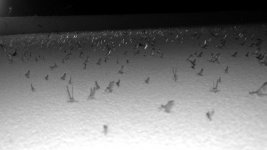Yeah, when a bunch of stuff is coming off, it's a combination of knowledge, observation, and experience. But it can be a tough situation, no doubt. If it were easy, this would be a boring sport!
Knowledge - this is the kind of thing where you know that Bug X hatches from riffly, rocky areas, and bug Y from slower water with silty bottoms. Or that bug X swims to the surface as a nymph and floats a while, while bug Y transforms on the bottom and flies to the surface, while bug Z isn't actually hatching, but laying eggs, and they do this by skittering the surface.
Observation - If you can see a bug get taken, that's great! But more often, you're observing rise forms. Sips and dimples? Porpoises? Splashy rises? All out jumps? When combined with knowledge, can help you determine which bug, and in what form, is being eaten.
Experience - If you've fished this stream and hole before, you know that the fish up in that thar riffle really like X emergers dead drifted, while those down thar in that tailout cruise around for the egg layers and require a bit of a skitter, but theyr'e all dinks. Meanwhile, the true hogs of this pool don't rise at all, they sit on the bottom in the deep, fast part over there and eat big honkin stonefly nymphs.
But be careful with the last category. It's easy to use it as a crutch, and be overly sure of yourself. Things change. Maybe you didn't notice that while not yet hatching, the Green Drake nymphs have become active, and those hogs in the deep fast water have moved to the slower water and kicked those dinks the heck out of there! What you thought was a dink making a splashy rise down there was actually a chub escaping a 20 inch brownie.
And that's what this sport is all about. Learning what's happening. It's why a casual observer, like a hiker, can never be as in tune with nature as a hunter or fishermen. They just can't ever notice these things.






